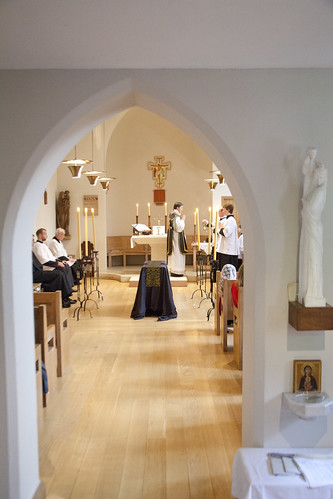 |
| A Traditional Requiem Mass in the chapel of St Benet's Hall, Oxford, in 2015. On the right the small statue is a scale model of 'Our Lady of Isles', a huge statue constructed on Catholic South Uist in the Hebrides in 1958. The model is I believe a working model made by the artist, Hew Lorimer. |
‘Though the island people as a whole were devout, he found that it was the men rather than the women who ‘practised’. He reckoned that throughout Uist and Barra men outnumbered women at Mass by as much as five to one. He believed that this situation had developed over many generations, in a society in which the women were often left at home on Sundays to tend the cattle and look after the house, and as a result were not only deprived of the sacraments but of any deep instruction in their religion.’
John Watts, A Record of Generous People: A History of the Catholic Church in Argyll and the Isles (2013) p156
The longer term background of this observation, if (as seems plausible) the situation in Fr MacDonald’s time did reflect many generations’ practice, is the dependence of these communities on itinerant priests visiting them, sometimes very infrequently, and celebrating Mass on ‘Mass rocks’ and in private houses: not because of an active persecution, for the most part, but simply because of the acute shortage of priests and funds. The parochial system was still only in embryonic form in Fr MacDonald’s time.
This, however, does not really explain the sex ratio Fr MacDonald observed. Not all his parishioners had a long walk to church, for example - indeed this would have been less of an issue on small islands than on the mountainous mainland. Why didn’t the men stay at home and let the women go to church?
Certainly, some women would have been detained by infants and domestic chores, but in this era in London, as described in detail by Callum Brown (The Death of Christian Britain) church attendance as a whole was correlated with the availability of domestic servants. In other words, it was female piety which got people to church, and when the mother of a family stayed at home to look after babies or cook Sunday lunch, no-one else went at all. The notion of female piety has persisted, with the female-skewed sex ratios in Christian congregations visible today.
(I've discussed Brown's thesis in more detail here.)
(I've discussed Brown's thesis in more detail here.)
Not so in the Catholic Hebrides of the 1890s. Clearly these communities had been sheltered from those ideas which suggested that religion belonged in the female sphere, such as emotionally-charged Low Church Protestantism and Romanticism. In a patriarchal society, where religion was taken seriously, if the father and mother of a family could not both attend Mass, it would be the father who went: obviously.
As I have observed before, Brown's generalisation is also contradicted by the observations about Catholic congregations in England and elsewhere of Mgr Hugh Benson, though not to quite such an extreme degree.
As I have observed before, Brown's generalisation is also contradicted by the observations about Catholic congregations in England and elsewhere of Mgr Hugh Benson, though not to quite such an extreme degree.
It is worth noting that these families had kept the Faith through centuries of extreme poverty and vanishingly limited clerical input. Indeed, self-identification as Catholic on South Uist was still 90% in in the 2011 census, and more than 80% on Barra. This is something those who attribute the survival of the Faith in Revolutionary France and Russia primarily to the fidelity of women should consider. Not because their claim is false, but because it is socially and historically contingent.
It would seem to suggest that the main issue is a lack of grace filtering through to the family via its head as a result of the protestant revolt.
ReplyDeleteIs that what kept them Catholic? Lol.
Delete